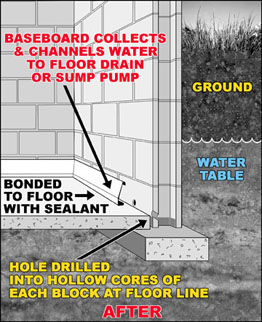Wet Basement Solutions
How can I stop water seepage from entering my basement?
Simple answer: There are two methods for doing this. Our method is a modern baseboard system (Real Dry™). The other method is an old-fashioned interior sub-floor tiling system.
Our Method – Real Dry™ Baseboard Channel
The Real Dry™ system is a baseboard channel system that controls hydrostatic water pressure at its source of entry. It is vinyl baseboard that is bonded to the floor and sits next to the wall. In a finished home, it takes the place of the baseboard trim that surrounds the foundation walls. Baseboard waterproofing is a use of new technology. The bonding agent is the key to a baseboard system. Real Dry uses an exclusive epoxy that is extremely strong. In fact, it’s stronger than the concrete floor that it is bonded to. It will set up under water, which means you don’t have to wait until your basement is dry to solve the problem. Finally, it does not break down over time. That means that it can be guaranteed for a very long time. The system can be drained to either a sump pit or floor drain (if allowed by your local municipality).
 Advantages
Advantages
1. Affordable: 1- to 2-day installation means less cost for you.
2. Non-invasive: Because your concrete floor isn’t torn up, there is virtually no dust and mess.
3. Repair work is also non-invasive.
4. Can be installed in finished homes as well as in homes that are not yet finished.
5. System can be painted.
6. Real Dry™ epoxy will not break down over time.
7. Real Dry™ epoxy will set up in wet environments. That means you don’t have to wait until your basement is dry to fix your problem.
8. Real Dry™ only deals with seepage that enters the structure, so humidity levels are not increased.
9. Real Dry™ can easily be sealed if radon gas is a concern or problem in your home.
Note: Real Dry™ epoxy is only available to professionally trained Basement De-Watering Systems® dealers and authorized installers.
Disadvantages
1. Cannot be used in sub-standard construction (red brick bat, sand stone block, dirt, or extremely thin concrete floors, and dirt floor crawlspaces).
 The Other Method – Sub-Floor Tile
The Other Method – Sub-Floor Tile
Sub-floor interior tile systems relieve hydrostatic water pressure from beneath the floor. They cut and remove the concrete floor from around the outside perimeter foundation wall. Then they dig a trench next to the footing. A field tile is inserted into the trench with aggregate rock. Some companies use a hybrid tile that also lies next to the wall. This is sometimes known as a French drain. Concrete is then poured to replace the broken floor. This system must drain into a sump pump pit.
Disadvantages:
 1. Extremely expensive due to the amount of labor involved.
1. Extremely expensive due to the amount of labor involved.
2. Very invasive: The concrete basement floor must be torn up, moving dirt and concrete through your home. Large amounts of messy concrete dust is produced due to the cutting up of the concrete.
3. Even if the system is guaranteed, repairs are also invasive. No matter how reputable the company, repairs are sometimes necessary. That means if you finish your basement and a tile system needs to be repaired, you may lose your improvements.
4. Average job time: 3 to 5 days.
5. Cutting and breaking concrete is messy business and creates massive amounts of dust. This creates secondary cleaning costs for the basement, duct work, and upstairs living area.
6. Because all sub-slab systems lie beneath the floor and have direct access to the water table and soil, they are subject to soil sediment, plant root systems and, if improperly installed, can undermine your foundation.
7. Hybrid systems (sub-slab systems that drain the wall as well as the foundation: ie: Basement Systems® WaterGuard System™) are open to the basement where the wall and floor meet. This can allow:
* an increase in humidity levels in the structure, which can be a precursor to dust mites and mold
* radon gas to enter your structure because the systems are not easily sealed
* the same issues as traditional sub-slab systems if your footing doesn’t extend at least four inches from the wall
8. Extremely difficult and messy to install when the water table is high. Installation may have to be delayed until ground dries out.
Advantages
1. Only system that can be used in sub-standard construction (red brick bat, sand stone block, dirt, or extremely thin concrete floors, and dirt floor crawlspaces).
Basement De-Watering Systems® has installed over six million feet in three countries. We’ve installed systems in schools, churches, businesses, unfinished basements, and million-dollar homes. Call us and let us eliminate your water seepage problem today.
So what are you WADING for?™
Make your basement Real Dry™, right now.







